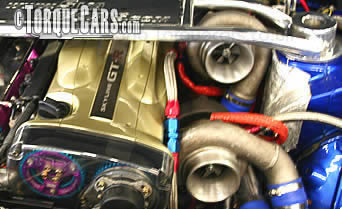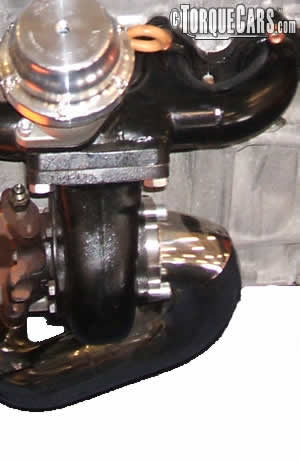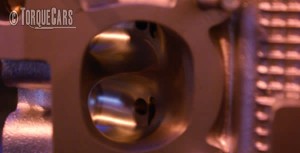Adding an aftermarket turbo to a car.
"Fully charged"
The basic reason for forced induction (turbo or supercharger) is not to increase compression or the maximum pressure in an engine cylinder, it is to increase volumetric efficiency (the efficiency of the engine at drawing in air) although forced induction is the most effective method of upping compression.
In computer games we just tick a box, and within seconds our car is fully turbocharged and running much faster. In the real world things are very different.
Things to take into account when adding a turbo to a non turbo car (NASP or naturally aspirated engine).
If you are thinking of adding a turbo to your car we suggest you join our friendly forum and get some specific tips and advice for your car model.
When a naturally aspirated engine sucks air in, it can only draw so much in before the intake valve closes and seals the cylinder. The average N/A engine will pull in around 60% of its volume, so as a result is only 60% volume efficient.
The more highly tuned an engine is the more efficient it will be, a typical TorqueCars member will have already spend much time and effort tuning their engines but will still struggle to get anything approaching 85% efficiency. The best way to improve this is to force the air/fuel mixture into the cylinders (forced induction) thus filling them more. The average forced induction engine runs from 110% to 150% volumetric efficiency.
Some examples of the result. a 2.0 N/A motor will use effectively around 1200-1300cc of its capacity and will produce upto an optimum 200bhp (based on 100bhp per 1000cc). A turbo'd or supercharged 2.0 will use much more of it's capacity, producing more power as it is able to burn more fuel. (With an optimum power figure far in excess of 100bhp per cylinder.)
For example a turbo charged 1.6 engine in a formula 1 application produced well over 1000bhp. We frequently see 2.0 turbo cars hitting 600bhp and more. The key is in having a strong block and components to work from.
The more boost you run, the more efficient the engine hence we have 1.4 litre turbo engines producing as much power as large v6's. But the main benefit from increasing boost is to increase the final compression ratio and getting a better bang from an increased air/fuel charge mix in your cylinders (the actual engines compression ratio stays the same but as there is more air coming into the engine it will become more compressed).
If you increase the amount of air/fuel in the cylinders, then as a result you will increase the compression, which could be too much. In order to keep the final running compression the same, the initial compression (without boost) has to be dropped to compensate.
More air will enable more oxygen to be available for burning and with the addition of additional fuel the engine will release more power. Turbo charging is the best way to increase the efficiency of an engine. When adding a turbo to an engine which was not originally designed for a turbo there are some major complications to take into account.
 Detonation or knock - this is where the fuel ignites under pressure before the spark happens. This will cause a piston to move in the opposite direction if it has not reached the top dead centre and will have disastrous consequences for the engine.
Detonation or knock - this is where the fuel ignites under pressure before the spark happens. This will cause a piston to move in the opposite direction if it has not reached the top dead centre and will have disastrous consequences for the engine.
To avoid detonation (premature ignition) you will need to lower the compression of the engine, and or restrict the turbo to a low boost threshold. (Low compression engines plus a turbo will also avoid some of the turbo lag problems inherent in most turbo applications.) The best turbos to add to a non turbo NASP (Naturally aspirated) engine are small with low boost levels. Another option you have is to fit a water injection kit to dampen the air charge and prevent detonation.
To lower the compression you can go with a re-bore and fit lower compression pistons, you can add a stroker kit to alter the compression ratio or for minor adjustments you could get a larger head and thicker head gasket thus increasing the cylinder size and reducing the compression ratio.
You need to aim for around a 7:1 compression ratio if you are adding a turbo, anything above 9:1 you will have problems. In all cases you should use the highest octane fuel that you can find as the higher the octane the more resistant the fuel is to engine knock.
If you can reduce the boost pressure to 5-7psi (as opposed to 25-35psi), and used the higher octane fuels available (e.g. Shell Optimax) you should be able to run a turbo on a standard engine with around the 9:1 compression ratio. For information on Octane and its effect on engine knock read our octane article.

When adding a turbo, for maximum performance gains, you should also get the head flowed increase the port size, fit bigger valves and go with a larger exhaust header and system as there will be a much larger volume flowing through the engine.
Fitting an adjustable boost controller will allow you to experiment on a rolling road while attached to diagnostic equipment to find the optimum boost pressure and timing advance.
Particular attention should be paid to fuelling. More air requires more fuel or you risk the danger of burning too lean. You also want to avoid overfuelling when the boost from the turbo drops as this can destroy the engine.
On most aftermarket turbo applications it is unlikely that the cars existing fuel delivery system will be able to deliver sufficient fuel so you will need to uprate the fuel pressure with a new pump and fuel pressure regulator, the injectors will also need uprating.
The car computer will also need to take into account the new fuelling requirements of a turbo, especially with regard to throttle position and wastegate control and rapidly changing fuel requirements between on and off boost conditions.
We strongly recommend a good aftermarket ECU to allow you to create a custom map for your new turbocharged engine.
Most kits contain only the necessary parts to physically get the turbo onto the engine such as an exhaust header and the necessary intake plumbing to the air filter.
Turbos are expensive but will add the most power for your money. You should allow about 40 hours for fitting, you really do need to know what you are doing and will require the ability to create a custom ECU map. Generally speaking though it will usually be easier to source a turbocharged engine and do a engine transplant to this than add a turbo to a NASP engine.
TorqueCars suggest that you join the friendly tuning forum and get some specific tips and advice for turbo charging your car model.
If you liked this page please share it with your friends, drop a link to it in your favourite forum or use the bookmarking options to save it to your social media profile.
Check out TorqueCars new YouTube channel, and see their awesome new content...
Feedback
Please use our forums if you wish to ask a tuning question, and please note we do not sell parts or services, we are just an online magazine.
Help us improve, leave a suggestion or tip
